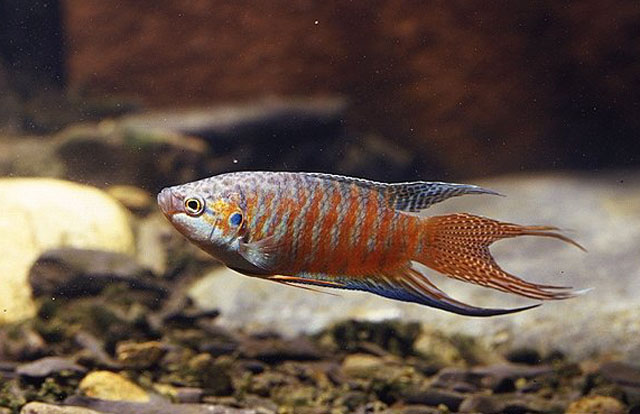| Osphronemidae (Gouramies), subfamily: Macropodusinae |
| 6.7 cm SL (male/unsexed) |
|
pelagic; freshwater; brackish; pH range: 6 - 8; dH range: 5 - 19 |
| Asia: China, from Yangtze basin to the south, on Hainan Island, in Taiwan, north Viet Nam; introduced to the tropical and subtropical world (Ref. 42924). Very popular with aquarists and has been widely transported around the world. |
|
Dorsal spines (total): 11-17; Dorsal soft rays (total): 5-10; Anal spines: 7-22; Anal soft rays: 9-15; Vertebrae: 27-29. Caudal fin forked, both lobes elongate in males (Ref. 559), with filamentous extension in each lobe (Ref. 43281); lower margin of preorbital sharply serrated (Ref. 559); conspicuous dark brown opercular spot with whitish posterior margin (margin red in life); body with 7-11 bold, dark bars on pale yellowish background in preserved specimens (blue bars on reddish background in life); dark stripe crossing eye connecting opercular spot with eye; top of head and predorsal body with dark spots; posterior tip or margin of scales on body not darker than scales (Ref. 42924). |
| Adults inhabit any kind of lowland habitats from heterogeneous structured margins or backwaters of large rivers to small streams and irrigation channels on farmland (Ref. 42924). Can colonize stagnant water bodies with very low oxygen content (air breather). Found in streams, paddy fields and ditches (Ref. 5258). Feed on small aquatic animals including small fish. First ornamental fish to be brought to Europe (France 1869, Germany 1876) after the goldfish (Ref. 13371). Males will fight each other (Ref. 1672). Aquarium keeping: minimum aquarium size 80 cm (Ref. 51539). |
|
Least Concern (LC); Date assessed: 02 September 2010 Ref. (130435)
|
| harmless |
Source and more info: www.fishbase.org. For personal, classroom, and other internal use only. Not for publication.
